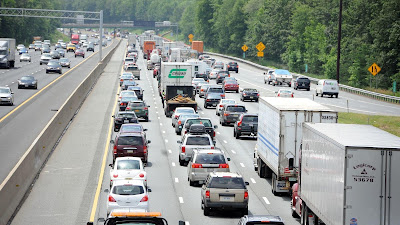The Parkway is still a reprieve, even though it has been blemished by big scars at BWI Arundel Mills, and route 32 where a third lanes has already been added and interchanges were rebuilt and although the two cities at its ends never paid much attention to receiving the grand old dame with any dignity at their respective gateways.
 |
| BW-Parkway today (NPS photo) |
Maryland's Governor has little sense for such considerations when he proposes to take the Parkway over from the National Park Service, get rid of the remaining aesthetic restrictions and add a lane in each direction. The added lanes would wipe clear whatever skinny landscape buffers are left of the once bucolic route and would make the scenic route just another pavement nightmare framed by concrete sound barriers.
Now another threat has emerged for the Parkway: An elevated high speed train-line to be erected in its right of way or hugging it closely. As was reported this week, the environmental studies underway for Maglev have picked the Parkway for two remaining alignment alternatives. The Governor has emerged as a friend of Maglev, presumably because the Japanese Consortium not only invited him to a test ride ints 350mph train, but also because the corporation promises to bring a significant down-payment to the first leg of the super train which would end somewhere in Baltimore's Westport. Adding the proposed takeover of the Parkway from the National Park Service and the preferred rail route together one can easily imagine where the journey is supposed to go. And it ain't a pretty picture.
 |
| I-95: four lanes, trucks and no green median (SUN photo) |
One would think that in anticipation of autonomous vehicles the aesthetics of a trip would once again come into focus since when all riders in a car would become passengers with the leisure to look left and right and take in what a journey has to offer. That same consideration should also hold true for future train passengers. The proposed Maglev running on stilts along the Parkway and in a tunnel for 75% of its trip doesn't promise much in terms of scenic views, quite in contrast to the current Amtrak and MARC line. Today's trains surprise travelers between DC and Baltimore with unexpected expansive swaths of green landscapes swooping by the windows. Even the entry into Baltimore with long views over the cityscape is quite impressive, provided one looks in the right direction (east) and can take the eyes off the decay and trash immediately along the tracks.
 |
| BW Parkway tomorrow: Widened and with Maglev? (MTA image) |
Historic preservation has become a widely recognized element in planning, architecture and urban design. It is time that transportation joins in with not only protecting scenic travel but making beauty once again an element of consideration.
It is not hard to imagine a near future where we look at our transportation arteries and see them with the same disdain which we developed for the time when urban-renewal and ugly pseudo-functional architecture replaced the patina of what had grown over time. One only needs to take a look at those recently widened Beltway sections, the ride on I-95 north of Baltimore, or the expanded NJ Turnpike between Philly and NYC, to see what easily could cause such disdain.
Already we see cities as places where quality of life should happen, where experiences are made and where streets need to be "complete", i.e. where they need to be much more than places for cars to travel. Why should the routes between cities be exempted from those same considerations?
Mindfulness means that we take a step back from the rat-race that our daily life has become so we can see trees, the sky, clouds and cows on green pastures. Scientists tell us that this makes us happy, lowers cortisol and adrenaline, and gives us the space to think creatively. It is time to rally against the destruction of the Parkway as a remaining "scenic" route and see it as an asset that connects two cities which through true collaboration could be global leaders in quality of metropolitan life.
Klaus Philipsen, FAIA
No comments:
Post a Comment